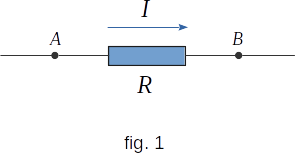From the Direct electric current
95. Joule–Lenz law for the circuit section
Let's return to the circuit section diagram shown in Figure 1. Potential difference at the ends of the circuit section \(\Delta{V} \,= \,Va-V_b.\,\) We know how to use the Ohm's law to find the force of electric current in a given circuit section if the potential difference and the resistance of the circuit section are known.

Now lets take a look at the work and power of the electric current. When moving electric charges from point \(A\) to point \(B\), the electric field performs work, which is determined by the difference of potentials \(\Delta{V_{ab}}.\) After all, the difference of potentials is a value equal to the work on the movement of a single positive charge. Let the charge \(Q\,\) pass through the cross section of the conductor in time \(t.\) Then the work done is equal to \(W \,= \,Q\,\Delta{V_{ab}}.\)
Since according to the definition of force of electric current \(\,I= \,\frac{Q}{t},\) this work can be written as
\( W \,= \,I\,\,\Delta{V_{ab}}\,t \) (9-5)
The power, i.e. the value equal to the work done by the electric current in one time unit, is equal to
\( P_e \,= \,\frac{W}{t} \,= \,I\,\,\Delta{V_{ab}} \) (9-6)
But according to the law of energy conservation, the done work must be equal to the change in the energy of the conductor section. Its mechanical energy obviously does not change. Consequently, the internal energy changes. And indeed, it is noticeable that the conductor through which the electric current flows heats up. So, equations \((9-5)\) and \((9-6)\) determine the quantity of heat released by electric current in a conductor in time \(t\) or in \(1 second.\) In this case \(W > 0\) and \(P > 0,\) because \(Va > V_b.\) When electric current passes through the AB section, energy is continuously supplied to this section, absorbed by the section and then released as heat.
The expression \((9-5)\) for the quantity of heat generated by the electric current was first established by the experimentally English scientist Joule and the Russian scientist Lenz. It is called the Law of Joule-Lenz. We obtained it with simple reasoning based on the law of energy conservation.
So far, we have not used the Ohm's law. If in equations \((9-5)\) and \((9-6)\) we replace with \((9-4)\) electric current and difference of potentials, we get other equivalent expressions of Joule-Lenz law.
\( W \,= \,I\,\,\Delta{V_{ab}}\,t \,=I^2\,R\,t \,= \,\frac{(\Delta{V_{ab}})^2}{R}t \)
\( P_e \,= \,I\,\,\Delta{V_{ab}} \,= \,I^2\,R \,= \,\frac{(\Delta{V_{ab}})^2}{R} \)
Any type of expression for \(W\) and \(P\) can be used for a uniform section of a circuit. When solving problems, it is reasonable to choose the most convenient equations for given case.